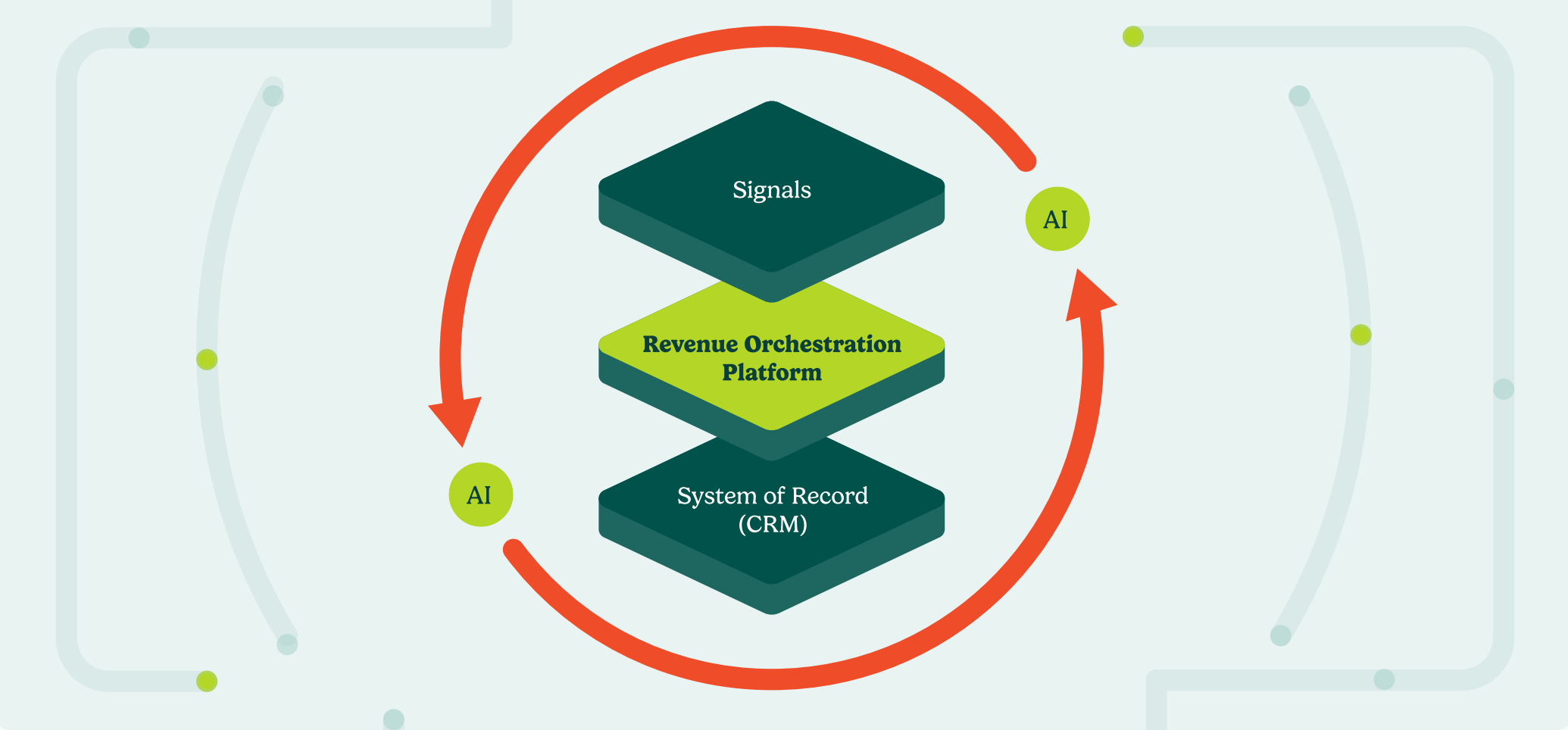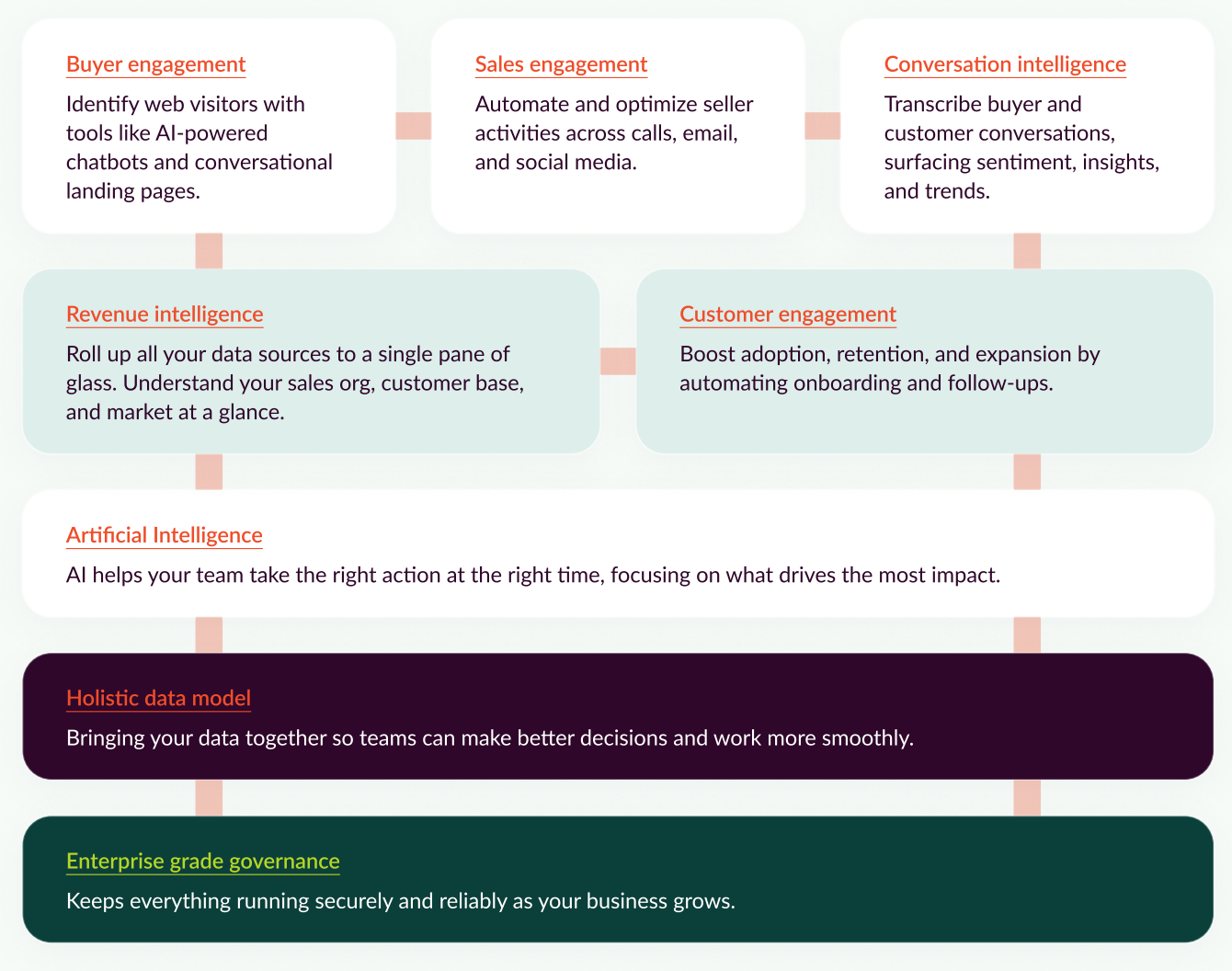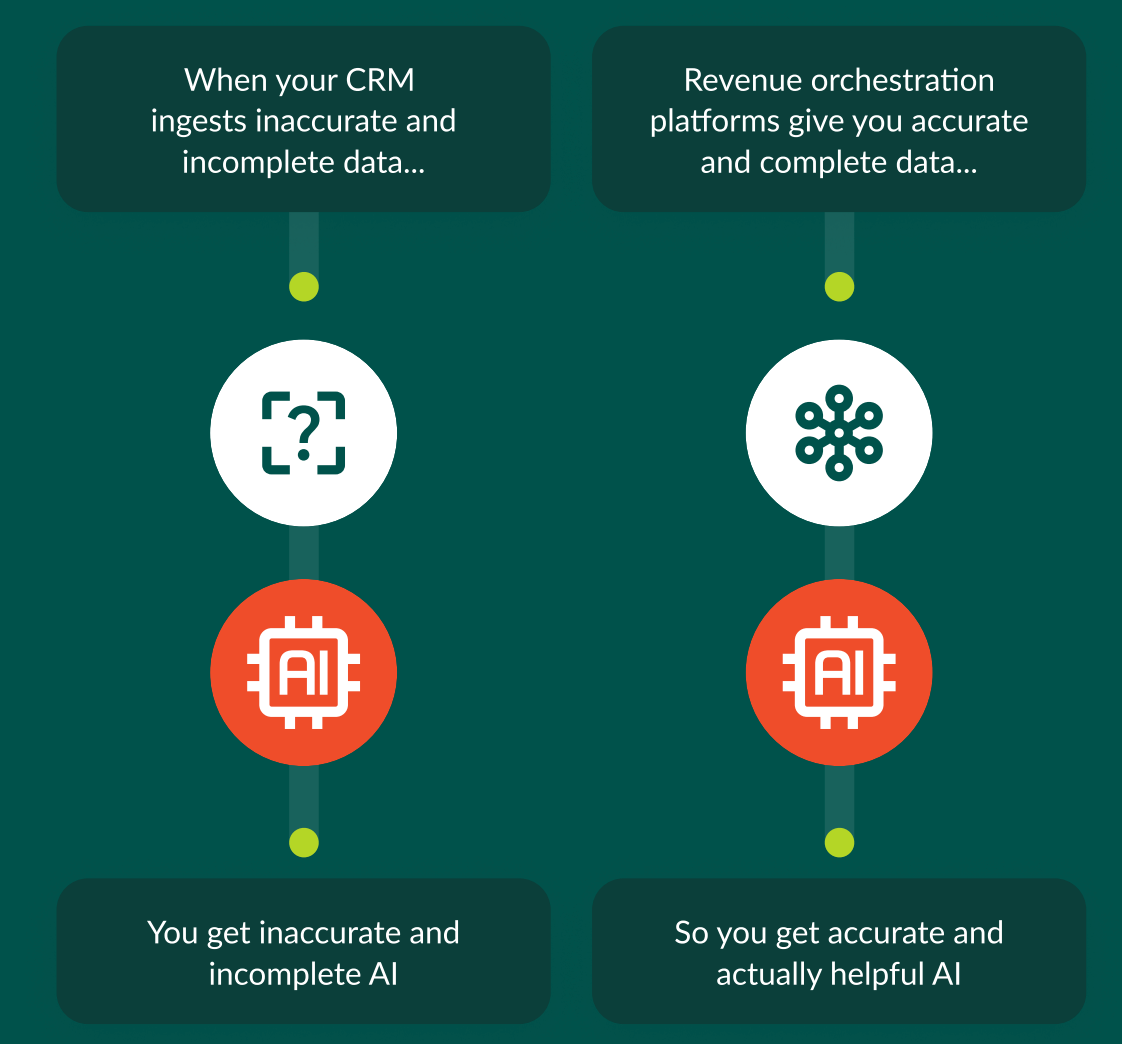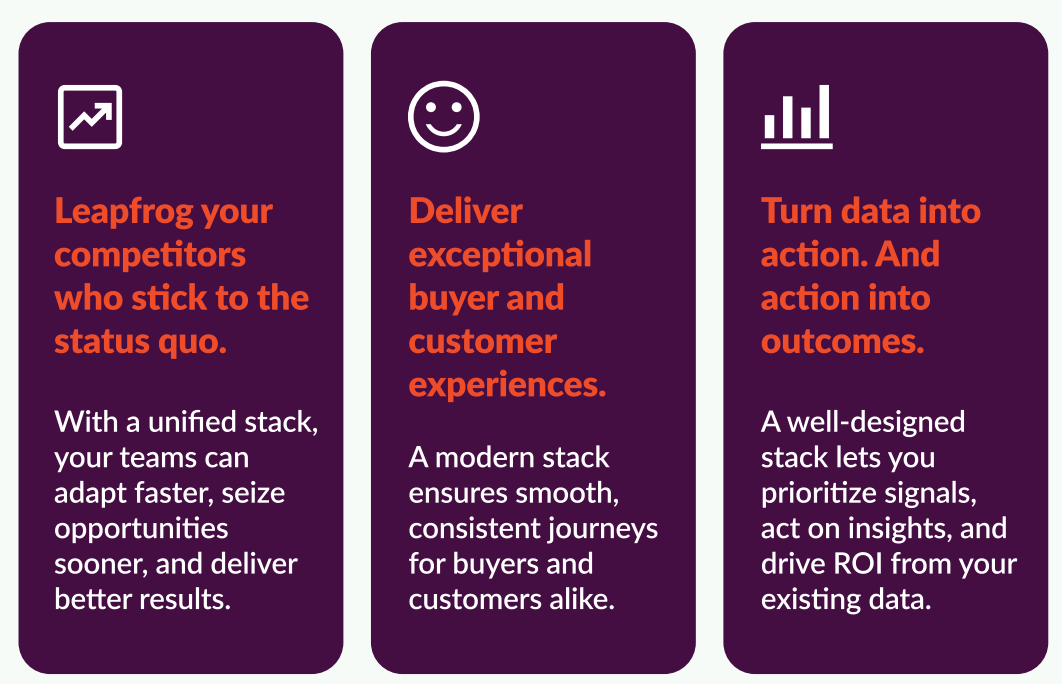How to Build a Revenue Tech Stack That Delivers on AI’s Promise
Published:

The AI promise – and the complicated reality
AI has the potential to transform go-to-market teams, offering the ability to make smarter decisions, foster collaboration, and achieve consistent growth. But for many organizations, the outcomes don’t match the promise.
The challenge isn’t the AI itself – it’s the tech stack supporting it.
AI relies on a unified foundation to deliver value. Yet, too often, fragmented tools and siloed data create barriers. Teams operate in isolation, opportunities slip through the cracks, and businesses struggle to adapt to shifting customer expectations.
This guide will show you how to architect a revenue tech stack that activates AI’s potential.
By unifying your tools, aligning your teams, and activating the right data, you’ll create a foundation that drives collaboration, adaptability, and durable revenue growth.
Why legacy stacks hold you back from maximizing your full value
Legacy Tech Stacks Block Meaningful Results
Whether it’s too many disconnected tools or outdated systems, legacy stacks lead to:
- Wasted Effort: Teams spend more time toggling between tools than selling.
- Missed Opportunities: Campaigns lack attribution, making their impact unclear.
- Stalled Growth: Customer success teams can’t effectively track churn risks or upsell opportunities.
Common Architectural Designs:
1. Point Solution Patchwork
- Issues: Disconnected tools create silos and inefficiencies.
- Impact: Scaling AI becomes impossible as pilot programs fail to collaborate across departments.
2. Manual Legacy Systems
- Issues: Low-tech setups with CRMs, email, and spreadsheets create bottlenecks.
- Impact: Teams are unable to adapt to fast-changing markets, limiting innovation.
Good News: Transitioning to a modern stack doesn’t mean starting from scratch. It’s about unifying your tools, aligning your teams, and building a scalable foundation for sustainable growth.
The benefits of a modern revenue tech stack
Transitioning to a modern revenue tech stack may seem like a big step, but it’s not about overhauling everything overnight. It’s a journey — one that evolves with your organization’s needs. Whether you’re a growing business or a large-scale organization, a modern tech stack is within reach, and the benefits are too big to ignore.
At a time when organizations are looking more closely at AI investments, an align by design approach to the development and deployment of AI can ensure that companies AI investments meet their intended objectives while adhering to organizational policies and principles.
The 4 components of a modern revenue tech stack
A successful revenue tech stack builds in layers, with each component strengthening the next:
Signals: Turning Insights into Action
AI: Helping Your Teams Work Smarter
Revenue Orchestration Platforms: Connecting It All
CRM: Supporting the System

1. Signals: Turning insights into action
Teams are inundated with data from website visits, trial sign-ups, and customer adoption. Disconnected tools scatter these signals, making it hard to identify what matters most. Revenue orchestration helps teams focus by prioritizing the signals that matter most. Instead of guessing what to do next, your marketing, sales, and customer success teams can act on clear insights to create real results.
Old Way: Legacy Tech Stack
- Signals scattered across tools — website visits, product usage, and feedback don’t connect.
- Teams operate in silos, acting on incomplete or irrelevant signals.
- Noise overwhelms teams, creating confusion instead of clarity.
- Opportunities are missed, and collaboration breaks down.
New Way: Unified Tech Stack
- Signals from the customer lifecycle are unified and distributed to the right teams.
- Seamless signal flow aligns sales, marketing, and customer success.
- Correlated signals drive clear, prioritized actions that impact revenue.
- Signals surface opportunities or risks, enabling effective collaboration.
Leveraging insights from signals positively impacts revenue process performance in two key ways: They can be used to identify and create opportunities with multiple buying group members and improve the quality of the opportunities being passed to the revenue development reps (RDRs) and sales, resulting in higher conversion rates; and better prioritization based on signals delivers new opportunities that were previously overlooked or hidden
2. AI: Helping your teams work smarter
Many teams struggle to see value from AI because it’s firing on incomplete data and fragmented systems. Without alignment across your go-to-market team, AI’s potential is limited, and inefficiencies persist. With the right foundation, AI becomes a powerful tool for your entire team. It turns accurate data into specific recommendations that help marketing, sales, and customer success work faster, focus on the right priorities, and get better results.
Old Way: Legacy Tech Stack
- AI deployed in silos—one tool for sales, another for marketing, none for customer success.
- Fragmented data leads to vague, unreliable recommendations.
- AI tools fail to adapt to team needs, creating frustration.
- Teams question AI’s value due to inconsistent results.
New Way: Unified Tech Stack
- AI works across teams, connecting insights from the entire customer journey.
- Predictive data identifies patterns and prioritizes high-impact opportunities.
- AI adapts to each team and integrates into workflows, recommending next-best actions.
- AI is paired with context and explainability, building trust and focusing on impactful actions.
- AI scales from pilot to production across the organization.
The decisions tech leaders make about AI infrastructure will determine whether their enterprises become AI leaders or laggards.
3. Revenue orchestration platforms: Connecting it all
The Conductor of Your Tech Stack
Revenue orchestration platforms unite all your revenue generation systems, consolidating and coordinating signals, actions, and outcomes
This ensures:
- Seamless Collaboration: Tools, teams, and data are connected under one system.
- Maximized Productivity: Orchestrated workflows align marketing, sales, and customer success.
- Smarter Decisions: Insights flow freely, driving faster, collaborative decisions.
- Automated Processes: AI-driven actions and automation accelerate growth.
The revenue orchestration platform is a new piece of the puzzle. It’s finally fulfilling a promise that revenue tech promised to give us.
From point solutions to a unified Revenue Orchestration platform

In the current sales technology landscape, where every provider emphasizes their AI capabilities, buyers should prioritize evaluating meaningful features that can significantly enhance productivity or performance. To maximize the benefits of generative AI insights, revenue orchestration platforms should serve as the central hub for all buyer interactions and signals.
4. CRM: Supporting the system
Data drives every decision for marketing, sales, and customer success teams, but CRMs often fall short. Manual data entry leaves gaps, resulting in incomplete insights and unclear next steps — slowing progress or worsening outcomes.
Revenue orchestration platforms complement CRMs by automating data capture across the customer lifecycle. This partnership delivers accurate insights, enabling AI to guide teams with timely, precise recommendations that improve collaboration, decisions, and results.
Together, CRM and orchestration form a unified foundation that turns insights into action across your go-to-market strategy.
Old Way: Legacy Tech Stack
- CRMs act as static record-keepers, storing fragmented data.
- Teams rely on outdated, manual processes to manage data.
- CRMs provide incomplete insights, leading to vague actions.
- Opportunities and risks are often missed due to siloed information.
New Way: Unified Tech Stack
- Revenue orchestration platforms automate data capture across the customer lifecycle.
- Data flows seamlessly between tools, enabling real-time collaboration and automation.
- Turn CRM data into clear, actionable insights by connecting to orchestration platforms.
- Unified signals help teams identify risks and opportunities earlier, driving stronger outcomes.
Sales reps spend, on average, more than one-quarter of their working hours on administrative tasks such as internal meetings, order booking, and expense reporting.
If your CRM data is wrong, the AI won’t get it right

Next step: Building your stack
Building a modern revenue tech stack is a journey that evolves as your organization matures. Here’s how to begin:
- Audit Your Current Tools: Identify gaps in signals, AI, revenue orchestration, and CRM.
- Define Goals: Set measurable outcomes tied to specific business results.
- Start Small: Focus on one impactful area, such as prioritizing high-value signals or deploying AI to connect data across teams.
- Iterate and Improve: Roll out changes in phases, adapt based on feedback, and scale what works.
- Invest in Orchestration: Use a revenue orchestration platform to unify tools, data, and teams.
Download the complete 10-step checklist to start building your revenue tech stack today.
Your tech stack reimagined
The promise of AI isn’t just about technology — it’s about enabling better decisions, aligning teams, and driving outcomes that matter. With signals, AI, revenue orchestration, and CRM working together, your stack becomes a powerful engine for growth. It’s not about being perfect on day one. It’s about starting where you are, building step by step, and staying ahead of competitors in a fast-changing market.
Ready to start your journey to modernization? Request a demo to see how Salesloft can help, or find out why Salesloft is a leader in revenue orchestration.






























